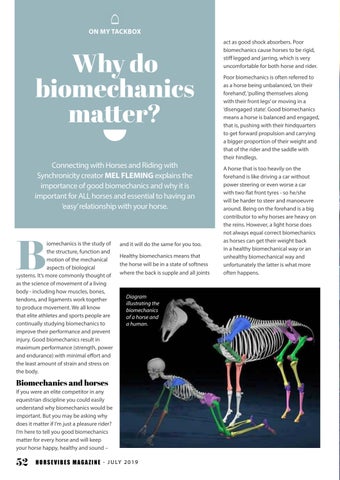ON MY TACKBOX
Why do biomechanics matter? Connecting with Horses and Riding with Synchronicity creator MEL FLEMING explains the importance of good biomechanics and why it is important for ALL horses and essential to having an ‘easy’ relationship with your horse.
B
iomechanics is the study of the structure, function and motion of the mechanical aspects of biological systems. It’s more commonly thought of as the science of movement of a living body - including how muscles, bones, tendons, and ligaments work together to produce movement. We all know that elite athletes and sports people are continually studying biomechanics to improve their performance and prevent injury. Good biomechanics result in maximum performance (strength, power and endurance) with minimal effort and the least amount of strain and stress on the body.
and it will do the same for you too. Healthy biomechanics means that the horse will be in a state of softness where the back is supple and all joints
Diagram illustrating the biomechanics of a horse and a human.
Biomechanics and horses If you were an elite competitor in any equestrian discipline you could easily understand why biomechanics would be important. But you may be asking why does it matter if I’m just a pleasure rider? I’m here to tell you good biomechanics matter for every horse and will keep your horse happy, healthy and sound –
52
H O R S E V I B E S M A G A Z I N E - J U LY 2 0 1 9
act as good shock absorbers. Poor biomechanics cause horses to be rigid, stiff legged and jarring, which is very uncomfortable for both horse and rider. Poor biomechanics is often referred to as a horse being unbalanced, ‘on their forehand’, ‘pulling themselves along with their front legs’ or moving in a ‘disengaged state’. Good biomechanics means a horse is balanced and engaged, that is, pushing with their hindquarters to get forward propulsion and carrying a bigger proportion of their weight and that of the rider and the saddle with their hindlegs. A horse that is too heavily on the forehand is like driving a car without power steering or even worse a car with two flat front tyres - so he/she will be harder to steer and manoeuvre around. Being on the forehand is a big contributor to why horses are heavy on the reins. However, a light horse does not always equal correct biomechanics as horses can get their weight back in a healthy biomechanical way or an unhealthy biomechanical way and unfortunately the latter is what more often happens.














